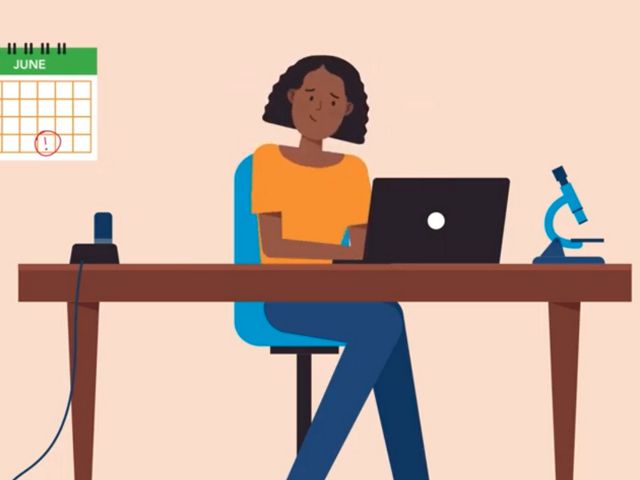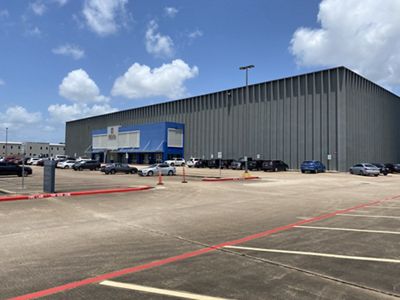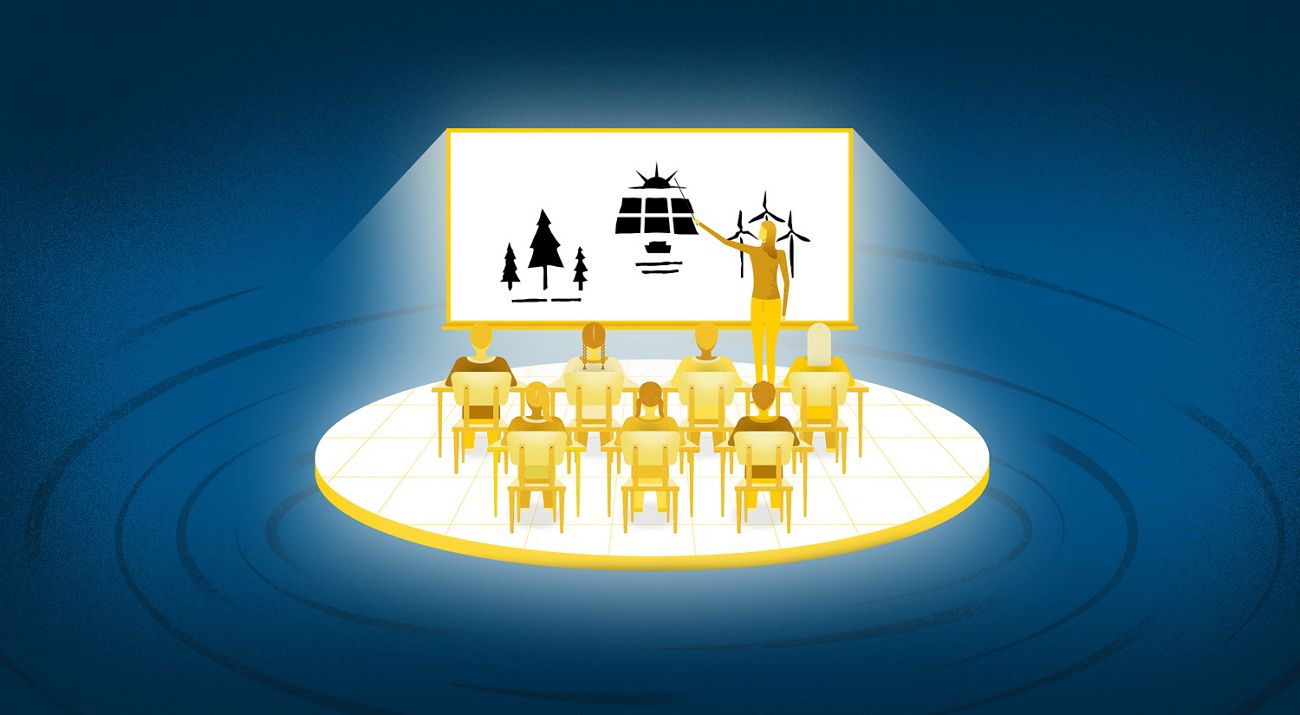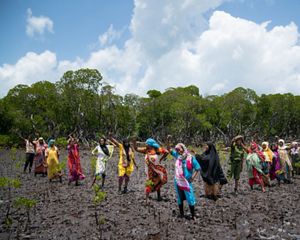With Great Care, Climate Change is in the Classroom
Balancing fact with tact, teachers seek to educate young people about climate change in ways that empower.
How would you bring up the topic of climate change to a room (or a Zoom) full of students? You might start with the imperiled polar bear, or maybe the Great Barrier Reef.
Jaime González’s choice is unavoidable: the storm that left some of his students without walls.
“I would literally start with footage of people being rescued from Hurricane Harvey,” says González, Houston Healthy Cities Director for The Nature Conservancy and a longtime environmental educator.
Once he had the class’s attention, he’d pivot to how climate change made the storm more destructive.
In 2017, Hurricane Harvey rapidly intensified before slowing to a halt over Southeast Texas, replenishing its moisture from the warm Gulf waters and dumping up to 60 inches of rain over three days.
Of the $125 billion in damage caused by Harvey, scientists determined that climate change was responsible for $60-90 billion of it.
Environmental lessons for all grades
Nature Lab provides resources for parents and teachers
Get resourcesNot all lessons must start with a disaster like Harvey.
But here in Houston, heat waves and 500-year floods are becoming more commonplace. He wants them to know that where they live can be considered a disaster zone. After all, a disaster happened here.
But scaring students is the last thing González, a conservationist dedicated to connecting Texans with their natural world, wants to do. His desire is to prepare them for the world ahead and empower them to advocate for change.
Educational standards matter, and they vary by state
Climate change is the challenge of our lifetimes, and we all have a vested interest in how it’s taught to the next generation. The good news is that most parents and teachers in the U.S. support teaching about climate change.
Obstacles still exist, but they’re often less about opposition from administrators or parents and more about issues of capacity.
In the U.S., state standards—goals for what students should know about subjects (like science) at various grade levels—play a major role in how climate change shows up in classrooms. Public schools cover their state’s science standards within their curricula and are evaluated on them through standardized test scores.
Most states update their standards every 5 to 10 years. They determine for themselves how to address climate change, leading to a lot of variation: just over half of states’ standards receive a B+ grade or higher for how they cover climate change.
Even in states where standards lack climate language, schools and teachers are covering it.
“We help support teachers to understand where this fits in during the school day,” says Kristi Hibler-Luton, Director of School Programs at EcoRise, an environmental education nonprofit started in Texas. “The standard doesn't have to say ‘climate change’ for us to talk about air quality or rising sea levels or ocean acidification.”
Reliable resources: what teachers need most
No matter the state or standard, teachers are more likely to include climate change in their lessons if 1) they’re confident in their understanding of the subject and 2) they have resources they can trust.
Many of today’s teachers never learned about climate change when they were students. Adult-centered climate trainings can give teachers the foundation they need, but only if educators can find time alongside lesson planning, grading and test prep.
Teaching during a pandemic has been a major challenge, but the disruption has helped teachers expand how and where they develop their lessons.
Want more of the stories that matter?
Sign up for the latest nature news each month
Get nature updates“With the lockdown from COVID-19, teachers had to do a lot of digital lessons. So they discovered a lot of online resources,” says John Vellardito, a science teacher at Greenwich High School in Connecticut.
Teachers are also seeking interactive tools that they can put in front of the most internet-fluent generation yet. Using visualizations from NASA, Aimee Farnum has her students sort through the data for themselves.
“Computer models are really where it blows their minds,” says Farnum, a science teacher at the same school as Vellardito. “I have never had a student that’s gone through that data and came out the other side saying ‘Well, this still isn’t a thing.’”
Many organizations are creating educational materials for teachers to use. TNC’s own Nature Lab is designed to meet teacher’s and parent’s educational needs, providing lesson plans, teaching guides and virtual field trips.
“Nature Lab digital curriculum can be a powerful tool for broadening access to nature and inspiring a new, diverse generation of informed stewards,” says Ximena Marquez, Associate Director of TNC’s Youth Engagement Program.

Educational Resources From Nature Lab
On The Nature Conservancy's youth curriculum platform, explore virtual field trips, teaching guides and more.
Teach kids about nature before covering climate change
In the race to create a spark with young people, we can’t afford to inadvertently blow out the flame. With urgency jumping from every headline and news report, one of the most important aspects of effective climate education is thoughtful restraint.
If we teach climate change right, students will value nature, become civically engaged, and be empowered to lead the changes our planet desperately needs.
But start too early or focus too much on catastrophic impacts and we could disempower and traumatize an entire generation of potential planetary heroes.
The most important thing we can do is build an early foundation around loving nature.
“We really need to engender a love of nature in the early grades,” says TNC’s Jaime González. “If kids aren’t quite equipped to help find solutions, they end up feeling like the environment is a problem: a place of hurt and pain to be avoided.”
Something can get lost when younger students spend less time on the wonders of nature and more on its problems.
Vellardito thinks his incoming 9th graders would make more meaningful connections with climate impacts if they had more time in middle school getting hooked on plants and animals. Why would coral bleaching matter to a student who doesn’t know or care about corals?
Quote: Aimee Farnum
It would be malpractice to teach climate change without teaching the idea that we already know the solutions.
How teachers can turn eco-anxiety into climate leadership
Farnum wanted to know how her 70 students were feeling about climate change, so she asked them. She hadn’t covered climate change with these students just yet. The results shocked her.
“Out of 70 students, only six of them said they weren’t anxious at all,” says Farnum. “The reasons given by the six who weren’t anxious were that they didn’t know enough to be anxious. So, students are nervous.”
Farnum and other teachers agree that climate-heavy lessons should lead with solutions and be action-oriented.
One reason is mental health. If anxiety over an uncertain future weren’t enough, other stressors from social media to pandemics are everywhere.
Vellardito takes care when covering the personal threats of climate change because student stress levels have continued to rise throughout his 20-year teaching career.
The other reason for leading with solutions: the prospect of students giving up or becoming prone to misinformation.
Washington, DC environmental educator Aleah Myers sees less eco-anxiety and more of “a mix of apathy—sentiments that individuals cannot make a difference—and frustration/anger about the systemic nature of the issue.”
“It’s a big cognitive issue for everybody of every age to get over,” says González, “because if you really think that the warming is baked in for 30 years, it’s like telling somebody, ‘you’re not going to be in good health for the next 10 years.’ That really is a demotivator, right?”
“It would be malpractice to teach climate change without teaching the idea that we already know the solutions,” says Farnum. “It’s relieving to a lot of students that we don't need to make something up, we just need to appreciate that trees sequester carbon, soil sequesters carbon, and we just need to manage it better.”
That doesn’t mean teachers are optimistic every day. “I just try to model enthusiasm, even if I don’t feel it myself in the moment,” says Farnum.
Her students, through their actions, give her hope. At the high school where she and Vellardito teach, the environmental club has grown to 120 students from a typical 25. And more students are going on to study environmental majors in college.
“Our students, no matter what direction they take in high school,” Farnum continues, “will be better off than the adults who currently are making the decisions.”
Inequity across education threatens climate progress
It’s hard to talk about U.S. schools, especially public schools, without acknowledging the many inequities present in the education system. These inequities make climate education uneven.
Within Aimee Farnum’s classroom, students are having aha moments by flipping through climate data layers and visualizations. This important part of her lesson is made possible by technology that not all public schools have equal access to.
“Our school is lucky, it’s one computer for every student,” acknowledges Farnum, “and we have Wi-Fi. Some schools don’t have broadband.”
And, as Jaime González points out, there are disparities apparent before even walking through school doors. School campuses in under-resourced communities often have much less tree cover and habitat than wealthier public school districts and private schools.
The differences in campuses often magnify discrepancies in access to nature in the neighborhoods served by these schools.

Especially in neighborhoods filled with concrete, school campuses can serve a critical need by creating habitat for people to learn from and enjoy. Thoughtful outdoor spaces are vital for the stress reduction, physical health benefits and improved academic performance they offer.
If we don’t improve access to nature in communities that need it, we risk holding back countless climate innovations and actions before they can spark.
“If you get everyday access to nature and an adult that models love of nature, you're gonna have a kid that loves nature and will advocate and vote for it,” says González. “If you don’t, their priorities go elsewhere.”
Quote: Jaime González
We need to hear them. Because frankly, if we had all the answers, we would've [solved climate change] already.
Climate change wisdom can come from anyone
Even if parents and teachers are slow to admit it, the teaching dynamic between parent and child or teacher and student has always been a two-way street.
Whereas previous generations have failed to curb the forces that are causing climate change, future generations cannot fail. And so while younger generations are learning, it would do older generations some good to unlearn.
It’s a time for humility, empathy and flexibility. Kids are growing up with a foundation in systems thinking, an intimate fluency with technology, and a sense of urgency they were seemingly born with.
The best—and least—we can do is listen.
“We need to hear them,” says González, a father to a 7-year-old.” Because frankly, if we had all the answers, we would have done it already.”
“It doesn’t matter whose mouth it’s coming out of, continues González. “Wisdom is wisdom.”
Want more stories?
Stay connected with news, tips and more from The Nature Conservancy.










